| ________________
CM . . . . Volume XXI Number 28 . . . . March 27, 2015

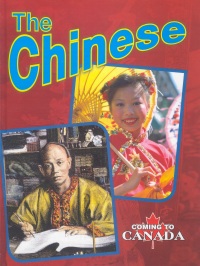
|
The Chinese. (Coming to Canada).
Annie Thomas.
Calgary, AB: Weigl Educational Publishers, 2015.
24 pp., pbk., hc. & ebook, $11.95 (pbk.), $23.95 (RLB), $34.95 (ebook).
ISBN 978-1-4872-0162-3 (pbk.), ISBN 978-1-4872-0161-6 (RLB), ISBN 978-1-4872-0163-0 (ebook).
Subject Headings:
Chinese Canadians-History-Juvenile literature.
Chinese-Canada-History-Juvenile literature.
Grades 3-6 / Ages 8-11.
Review by Gail Hamilton.
*** /4
|
| |
|
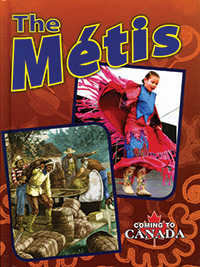
|
The Métis. (Coming to Canada).
Sara Mitchell.
Calgary, AB: Weigl Educational Publishers, 2015.
24 pp., pbk., hc. & ebook, $11.95 (pbk.), $23.95 (RLB), $34.95 (ebook).
ISBN 978-1-4872-0165-4 (pbk.), ISBN 978-1-4872-0164-7 (RLB), ISBN 978-1-4872-0166-1 (ebook).
Subject Heading:
Métis-History-Juvenile literature.
Grades 3-6 / Ages 8-11.
Review by Gail Hamilton.
*** /4
|
| |
|
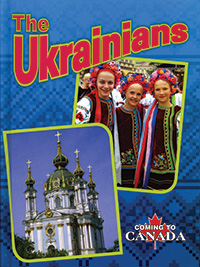
|
The Ukrainians. (Coming to Canada).
Sara Mitchell.
Calgary, AB: Weigl Educational Publishers, 2015.
24 pp., pbk., hc. & ebook, $11.95 (pbk.), $23.95 (RLB), $34.95 (ebook).
ISBN 978-1-4872-0159-3 (pbk.), ISBN 978-1-4872-0158-6 (RLB), ISBN 978-1-4872-0160-9 (ebook).
Subject Headings:
Ukrainian Canadians-History-Juvenile literature.
Ukrainians-Canada-History-Juvenile literature.
Grades 3-6 / Ages 8-11.
Review by Gail Hamilton.
*** /4
|
| |
|
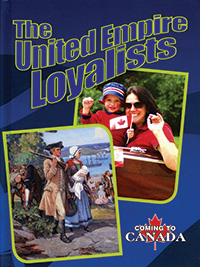
|
The United Empire Loyalists. (Coming to Canada).
Sara Mitchell.
Calgary, AB: Weigl Educational Publishers, 2015.
24 pp., pbk., hc. & ebook, $11.95 (pbk.), $23.95 (RLB), $34.95 (ebook).
ISBN 978-1-4872-0156-2 (pbk.), ISBN 978-1-4872-0155-5 (RLB), ISBN 978-1-4872-0157-9 (ebook).
Subject Headings:
United Empire Loyalists-Juvenile literature.
Canada-History-1763-1791-Juvenile literature.
Grades 3-6 / Ages 8-11.
Review by Gail Hamilton.
*** /4
|
| |
|

excerpt:
As hunters and fur traders, the Métis were great travelers. Their developments in both land and river transportation greatly helped the exploration of the Northwest. The Métis developed a new boat, called a York boat, that was based on fishing boats used on the Orkney Islands, off the coast of Scotland. The York boat could carry up to 12 people at a time. With its invention, fur traders, who had previously used canoes, could now carry a greater amount of goods.
The Métis also invented the Red River cart. The cart's wide wheels made it ideal for travel on the plains. It was light enough to float across rivers, and strong enough to carry heavy loads. The Red River cart was made entirely of wood and hide, so it could be repaired easily. Even the nails were made of wood. A horse-drawn Red River cart could carry the same amount of cargo as four packhorses. (From The Métis.)
Six titles currently comprise the "Coming to Canada" series which focuses on the various groups of people that have made this country their home. Each book has 10 chapters which cover such topics as immigration, history, settlement, daily life, culture, contributions to Canada, and the group's evolvement in modern-day times. Serious issues, such as Ukrainian internment and the Chinese Head Tax imposed on Chinese refugees by the Canadian government, are not glossed over; rather, they are explained in an age-appropriate manner to help readers understand the hardships that many immigrants faced. Banner-shaped text boxes provide additional facts, statistics and trivia. One example is that, in 2011, Chinese was the nation's third most commonly spoken language after English and French, with about 800,000 speakers. Illustrations, consisting of maps, drawings, colour photos and black and white archival photos, enhance the text. A table of contents, a glossary and an index are provided as is a short quiz for readers to test their recall of the facts. Each title also lists three related web sites for further research, along with a brief description of the web sites, with such topics as key events that influenced immigration of a particular group, settlement patterns, and virtual museum tours.
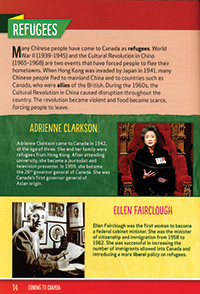 The first Chinese people to arrive in Canada were brought to Vancouver Island in 1788 by Captain John Meares, a British fur trader. Meares was so impressed by these 50 hard-working men that he brought another 70 men from China the next year. Following a 70-year gap, Chinese immigrants arrived here when gold was discovered and again when the construction of the Canadian Pacific Railway began. Today, there are 1.3 million Chinese people in Canada, representing four per cent of the country's population. In The Chinese, readers will learn about the extremely dangerous working conditions that the Chinese endured while working on the railway (it was said that for every mile of track laid, six Chinese workers died), the development of "Chinatowns", and the rich Chinese culture with its traditions and customs.
The first Chinese people to arrive in Canada were brought to Vancouver Island in 1788 by Captain John Meares, a British fur trader. Meares was so impressed by these 50 hard-working men that he brought another 70 men from China the next year. Following a 70-year gap, Chinese immigrants arrived here when gold was discovered and again when the construction of the Canadian Pacific Railway began. Today, there are 1.3 million Chinese people in Canada, representing four per cent of the country's population. In The Chinese, readers will learn about the extremely dangerous working conditions that the Chinese endured while working on the railway (it was said that for every mile of track laid, six Chinese workers died), the development of "Chinatowns", and the rich Chinese culture with its traditions and customs.
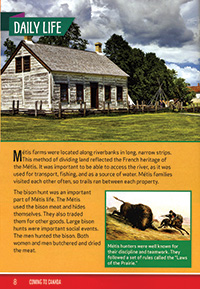 The first Métis were the children of First Nations women and French or Scottish fur traders. Today, there are more than 450,000 Métis people living in Canada. Since 1982, they have been recognized as a distinct Aboriginal people by the federal government. In The Métis, there is information about their contributions to both early Canadian history and to present day Canada. From 1670-1869, many Métis were employed in the fur trade as trappers, couriers, cargo haulers, boat builders and clerks, and their efforts helped to open up the West. Other topics in this title include important aspects of Métis life, such as the bison hunt, fishing and the rendezvous (a week-long celebration that included music, dancing and horse racing), the Michif language, important contributions, such as the York boat and the Red River cart, and the Métis' role in the Red River and Northwest Rebellions.
The first Métis were the children of First Nations women and French or Scottish fur traders. Today, there are more than 450,000 Métis people living in Canada. Since 1982, they have been recognized as a distinct Aboriginal people by the federal government. In The Métis, there is information about their contributions to both early Canadian history and to present day Canada. From 1670-1869, many Métis were employed in the fur trade as trappers, couriers, cargo haulers, boat builders and clerks, and their efforts helped to open up the West. Other topics in this title include important aspects of Métis life, such as the bison hunt, fishing and the rendezvous (a week-long celebration that included music, dancing and horse racing), the Michif language, important contributions, such as the York boat and the Red River cart, and the Métis' role in the Red River and Northwest Rebellions.
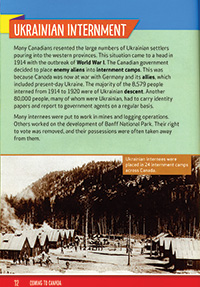 Comprising the ninth largest ethnic group in Canada today, the Ukrainians first arrived here in the 1890s. Posters in Eastern and Central Europe advertised up to 64 hectares of free land and cheap passage by steamship to those interested in settling in the prairie provinces. Ukrainian immigrants proved to be hard-working and were instrumental in developing farmland in the West. Following a brief history of the waves of Ukrainian immigration and settlement, The Ukrainians highlights the culture with its folk dance tradition, embroidery, and pysanky (Easter eggs). Also discussed are Ukrainian internment, Holodomor, and the development of Ukrainian communities in Alberta, Saskatchewan and Manitoba. (One minor flaw in the title is that the country, Ukraine, is always referred to as "the" Ukraine, which is no longer considered correct since the collapse of the Soviet Union.)
Comprising the ninth largest ethnic group in Canada today, the Ukrainians first arrived here in the 1890s. Posters in Eastern and Central Europe advertised up to 64 hectares of free land and cheap passage by steamship to those interested in settling in the prairie provinces. Ukrainian immigrants proved to be hard-working and were instrumental in developing farmland in the West. Following a brief history of the waves of Ukrainian immigration and settlement, The Ukrainians highlights the culture with its folk dance tradition, embroidery, and pysanky (Easter eggs). Also discussed are Ukrainian internment, Holodomor, and the development of Ukrainian communities in Alberta, Saskatchewan and Manitoba. (One minor flaw in the title is that the country, Ukraine, is always referred to as "the" Ukraine, which is no longer considered correct since the collapse of the Soviet Union.)
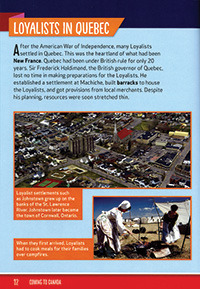 In 1783, following the War of Independence, approximately 50,000 Loyalists left the United States for Canada to live under British rule. Offered free land by King George III, they arrived here hoping for a better life. The United Empire Loyalists features information about the daily lives of the early Loyalists who built log cabins, established sawmills, and held community bees in order to complete large projects, such as building a barn, clearing land, making quilts, processing wool or shelling corn. Their arrival in Canada, along with their supporters, helped to make Canada both multilingual and multicultural, some examples of which are the establishment of the first African American communities, and the welcoming of religious minorities which included Quakers, Mennonites and French Protestants. Perhaps the Loyalists' greatest legacy is the creation of New Brunswick and the splitting of Quebec into Upper and Lower Canada. Other topics in this title include the plight of Black Loyalists, famous supporters such as Mohawk leader Joseph Brant, and John Graves Simcoe, the first Lieutenant Governor of Upper Canada, who not only had a network of roads and bridges built, but who also was responsible for the abolishment of slavery in Upper Canada and encouraged immigration from Great Britain and the United States.
In 1783, following the War of Independence, approximately 50,000 Loyalists left the United States for Canada to live under British rule. Offered free land by King George III, they arrived here hoping for a better life. The United Empire Loyalists features information about the daily lives of the early Loyalists who built log cabins, established sawmills, and held community bees in order to complete large projects, such as building a barn, clearing land, making quilts, processing wool or shelling corn. Their arrival in Canada, along with their supporters, helped to make Canada both multilingual and multicultural, some examples of which are the establishment of the first African American communities, and the welcoming of religious minorities which included Quakers, Mennonites and French Protestants. Perhaps the Loyalists' greatest legacy is the creation of New Brunswick and the splitting of Quebec into Upper and Lower Canada. Other topics in this title include the plight of Black Loyalists, famous supporters such as Mohawk leader Joseph Brant, and John Graves Simcoe, the first Lieutenant Governor of Upper Canada, who not only had a network of roads and bridges built, but who also was responsible for the abolishment of slavery in Upper Canada and encouraged immigration from Great Britain and the United States.
With just enough information and without overwhelming the reader with lengthy historical details, the "Coming to Canada" series which celebrates the traditions and contributions of various ethnic groups to the fabric of Canada will prove valuable for classroom use.
Recommended.
Gail Hamilton is a former teacher-librarian in Winnipeg, MB.
 To comment on this title or this review, send mail to cm@umanitoba.ca.
To comment on this title or this review, send mail to cm@umanitoba.ca.
Copyright © the Manitoba Library Association. Reproduction for personal use is permitted only if this copyright notice is maintained. Any other reproduction is prohibited without permission.
Next Review |
Table of Contents for This Issue
- March 27, 2015.
CM Home
| Back Issues
| Search
| CM Archive
| Profiles Archive
|




 The first Chinese people to arrive in Canada were brought to Vancouver Island in 1788 by Captain John Meares, a British fur trader. Meares was so impressed by these 50 hard-working men that he brought another 70 men from China the next year. Following a 70-year gap, Chinese immigrants arrived here when gold was discovered and again when the construction of the Canadian Pacific Railway began. Today, there are 1.3 million Chinese people in Canada, representing four per cent of the country's population. In The Chinese, readers will learn about the extremely dangerous working conditions that the Chinese endured while working on the railway (it was said that for every mile of track laid, six Chinese workers died), the development of "Chinatowns", and the rich Chinese culture with its traditions and customs.
The first Chinese people to arrive in Canada were brought to Vancouver Island in 1788 by Captain John Meares, a British fur trader. Meares was so impressed by these 50 hard-working men that he brought another 70 men from China the next year. Following a 70-year gap, Chinese immigrants arrived here when gold was discovered and again when the construction of the Canadian Pacific Railway began. Today, there are 1.3 million Chinese people in Canada, representing four per cent of the country's population. In The Chinese, readers will learn about the extremely dangerous working conditions that the Chinese endured while working on the railway (it was said that for every mile of track laid, six Chinese workers died), the development of "Chinatowns", and the rich Chinese culture with its traditions and customs.
 The first Métis were the children of First Nations women and French or Scottish fur traders. Today, there are more than 450,000 Métis people living in Canada. Since 1982, they have been recognized as a distinct Aboriginal people by the federal government. In The Métis, there is information about their contributions to both early Canadian history and to present day Canada. From 1670-1869, many Métis were employed in the fur trade as trappers, couriers, cargo haulers, boat builders and clerks, and their efforts helped to open up the West. Other topics in this title include important aspects of Métis life, such as the bison hunt, fishing and the rendezvous (a week-long celebration that included music, dancing and horse racing), the Michif language, important contributions, such as the York boat and the Red River cart, and the Métis' role in the Red River and Northwest Rebellions.
The first Métis were the children of First Nations women and French or Scottish fur traders. Today, there are more than 450,000 Métis people living in Canada. Since 1982, they have been recognized as a distinct Aboriginal people by the federal government. In The Métis, there is information about their contributions to both early Canadian history and to present day Canada. From 1670-1869, many Métis were employed in the fur trade as trappers, couriers, cargo haulers, boat builders and clerks, and their efforts helped to open up the West. Other topics in this title include important aspects of Métis life, such as the bison hunt, fishing and the rendezvous (a week-long celebration that included music, dancing and horse racing), the Michif language, important contributions, such as the York boat and the Red River cart, and the Métis' role in the Red River and Northwest Rebellions.
 Comprising the ninth largest ethnic group in Canada today, the Ukrainians first arrived here in the 1890s. Posters in Eastern and Central Europe advertised up to 64 hectares of free land and cheap passage by steamship to those interested in settling in the prairie provinces. Ukrainian immigrants proved to be hard-working and were instrumental in developing farmland in the West. Following a brief history of the waves of Ukrainian immigration and settlement, The Ukrainians highlights the culture with its folk dance tradition, embroidery, and pysanky (Easter eggs). Also discussed are Ukrainian internment, Holodomor, and the development of Ukrainian communities in Alberta, Saskatchewan and Manitoba. (One minor flaw in the title is that the country, Ukraine, is always referred to as "the" Ukraine, which is no longer considered correct since the collapse of the Soviet Union.)
Comprising the ninth largest ethnic group in Canada today, the Ukrainians first arrived here in the 1890s. Posters in Eastern and Central Europe advertised up to 64 hectares of free land and cheap passage by steamship to those interested in settling in the prairie provinces. Ukrainian immigrants proved to be hard-working and were instrumental in developing farmland in the West. Following a brief history of the waves of Ukrainian immigration and settlement, The Ukrainians highlights the culture with its folk dance tradition, embroidery, and pysanky (Easter eggs). Also discussed are Ukrainian internment, Holodomor, and the development of Ukrainian communities in Alberta, Saskatchewan and Manitoba. (One minor flaw in the title is that the country, Ukraine, is always referred to as "the" Ukraine, which is no longer considered correct since the collapse of the Soviet Union.)
 In 1783, following the War of Independence, approximately 50,000 Loyalists left the United States for Canada to live under British rule. Offered free land by King George III, they arrived here hoping for a better life. The United Empire Loyalists features information about the daily lives of the early Loyalists who built log cabins, established sawmills, and held community bees in order to complete large projects, such as building a barn, clearing land, making quilts, processing wool or shelling corn. Their arrival in Canada, along with their supporters, helped to make Canada both multilingual and multicultural, some examples of which are the establishment of the first African American communities, and the welcoming of religious minorities which included Quakers, Mennonites and French Protestants. Perhaps the Loyalists' greatest legacy is the creation of New Brunswick and the splitting of Quebec into Upper and Lower Canada. Other topics in this title include the plight of Black Loyalists, famous supporters such as Mohawk leader Joseph Brant, and John Graves Simcoe, the first Lieutenant Governor of Upper Canada, who not only had a network of roads and bridges built, but who also was responsible for the abolishment of slavery in Upper Canada and encouraged immigration from Great Britain and the United States.
In 1783, following the War of Independence, approximately 50,000 Loyalists left the United States for Canada to live under British rule. Offered free land by King George III, they arrived here hoping for a better life. The United Empire Loyalists features information about the daily lives of the early Loyalists who built log cabins, established sawmills, and held community bees in order to complete large projects, such as building a barn, clearing land, making quilts, processing wool or shelling corn. Their arrival in Canada, along with their supporters, helped to make Canada both multilingual and multicultural, some examples of which are the establishment of the first African American communities, and the welcoming of religious minorities which included Quakers, Mennonites and French Protestants. Perhaps the Loyalists' greatest legacy is the creation of New Brunswick and the splitting of Quebec into Upper and Lower Canada. Other topics in this title include the plight of Black Loyalists, famous supporters such as Mohawk leader Joseph Brant, and John Graves Simcoe, the first Lieutenant Governor of Upper Canada, who not only had a network of roads and bridges built, but who also was responsible for the abolishment of slavery in Upper Canada and encouraged immigration from Great Britain and the United States.